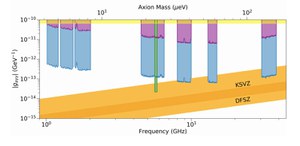Axions, Magnetars, and the VLA
 Axions are a leading candidate for cold Dark Matter. Axions may convert their rest energy into photons in extreme magnetic field regions, such as the > 1014 G fields that exist around Magnetars – the strongest fields known in the Universe. Such conversion would produce photons in the range of 0.2 GHz to 20 GHz.
Axions are a leading candidate for cold Dark Matter. Axions may convert their rest energy into photons in extreme magnetic field regions, such as the > 1014 G fields that exist around Magnetars – the strongest fields known in the Universe. Such conversion would produce photons in the range of 0.2 GHz to 20 GHz.
In this paper, PI Jeremy Darling reports on a search for dark matter axion conversion photons from the magnetosphere of the Galactic Center magnetar PSR J1745-2900 using spectra obtained from the Karl G. Jansky VLA. No significant spectral features are detected. Using a hybrid model for PSR J1745-2900 and canonical assumptions about the dark matter density profile, Darling could exclude axion models with axion-photon coupling gaγγ > 6–34×10−12 GeV−1 with 95% confidence over the mass ranges 4.2–8.4, 18.6–26.9, 33.0–41.4, 53.7–62.1, and 126.0–159.3 μeV. If there is a dark matter cusp, the limits reduce to gaγγ > 6–34×10−14 GeV−1, which overlap some axion models for the observed mass ranges >33 μeV. These limits may be improved by modeling the stimulated emission that can boost the axion-photon conversion process. The radio non-detection provides one of the best limits to date on the Axion-photon coupling constant.
Figure caption: Limits on the Axion-photon coupling constant from the VLA in PSR J1745-2900). Yellow regions are current models for the Axion magnetic coupling constant for a reasonable range in Axion mass. The green box indicates the best laboratory limits to date.
Publication: Jeremy Darling (University of Colorado), Search for Axionic Dark Matter Using the Magnetar PSR J1745-2900, Physics Review Letters, 125, 121103 (17 September 2020).




Connect with NRAO